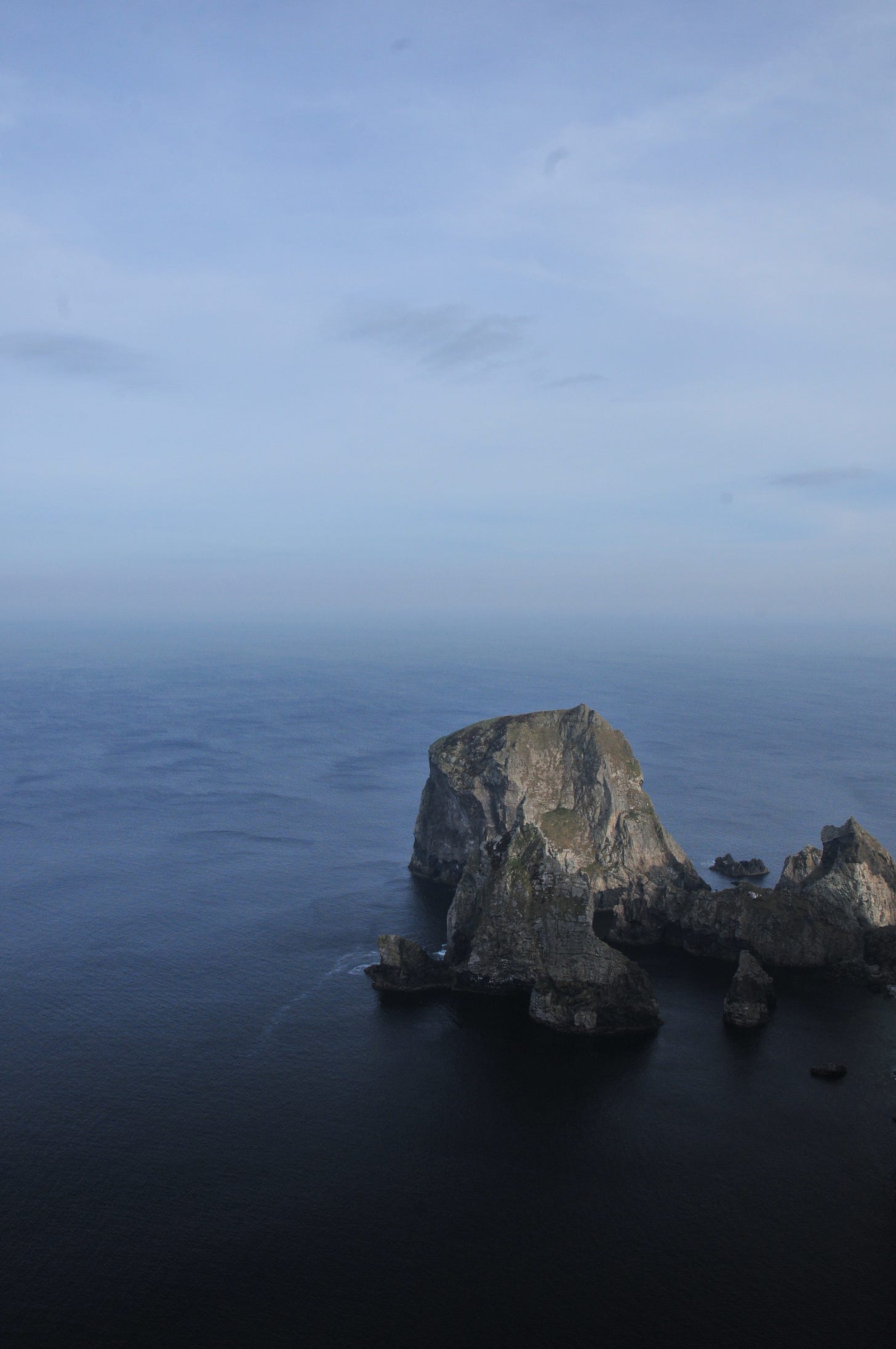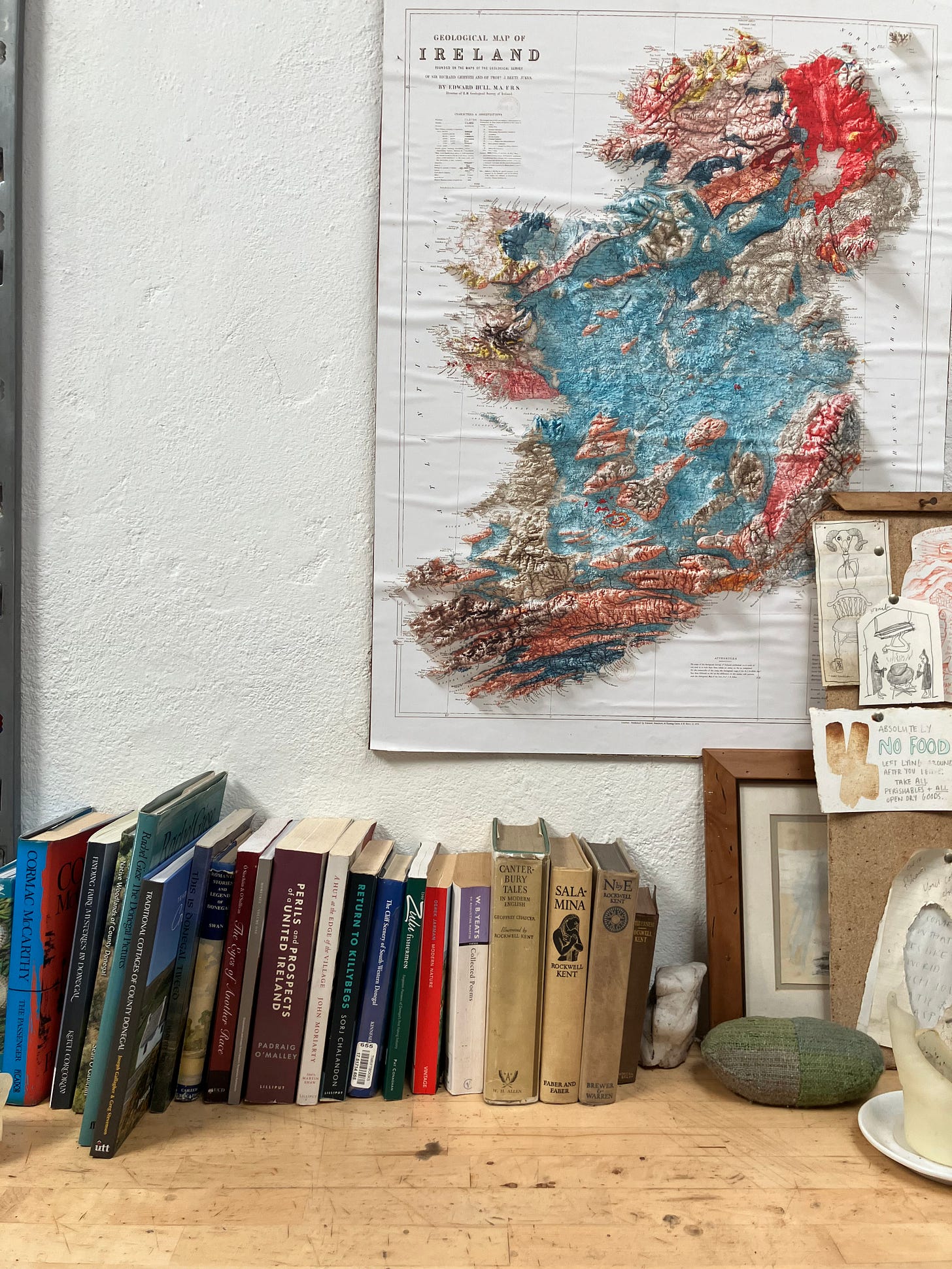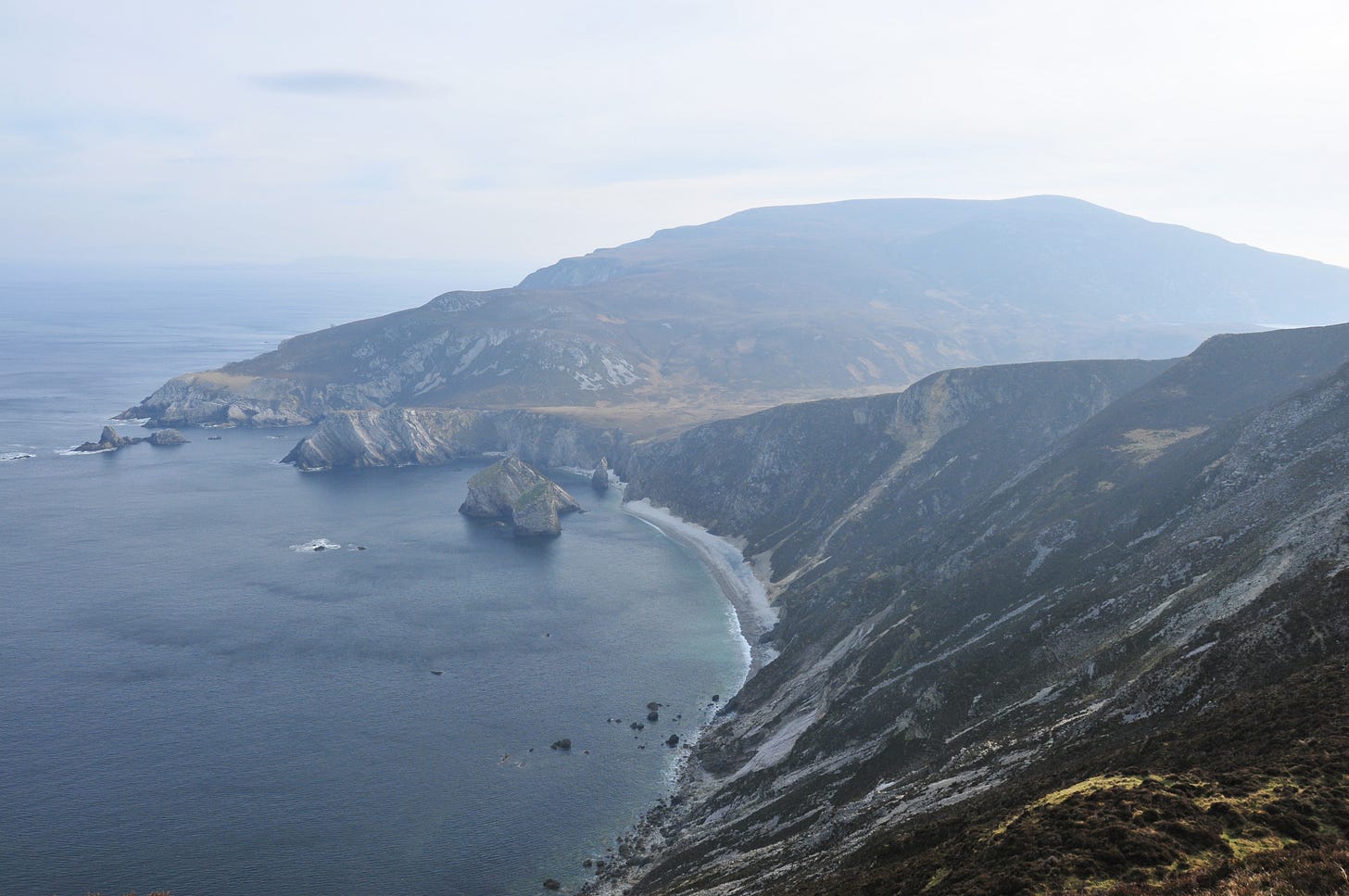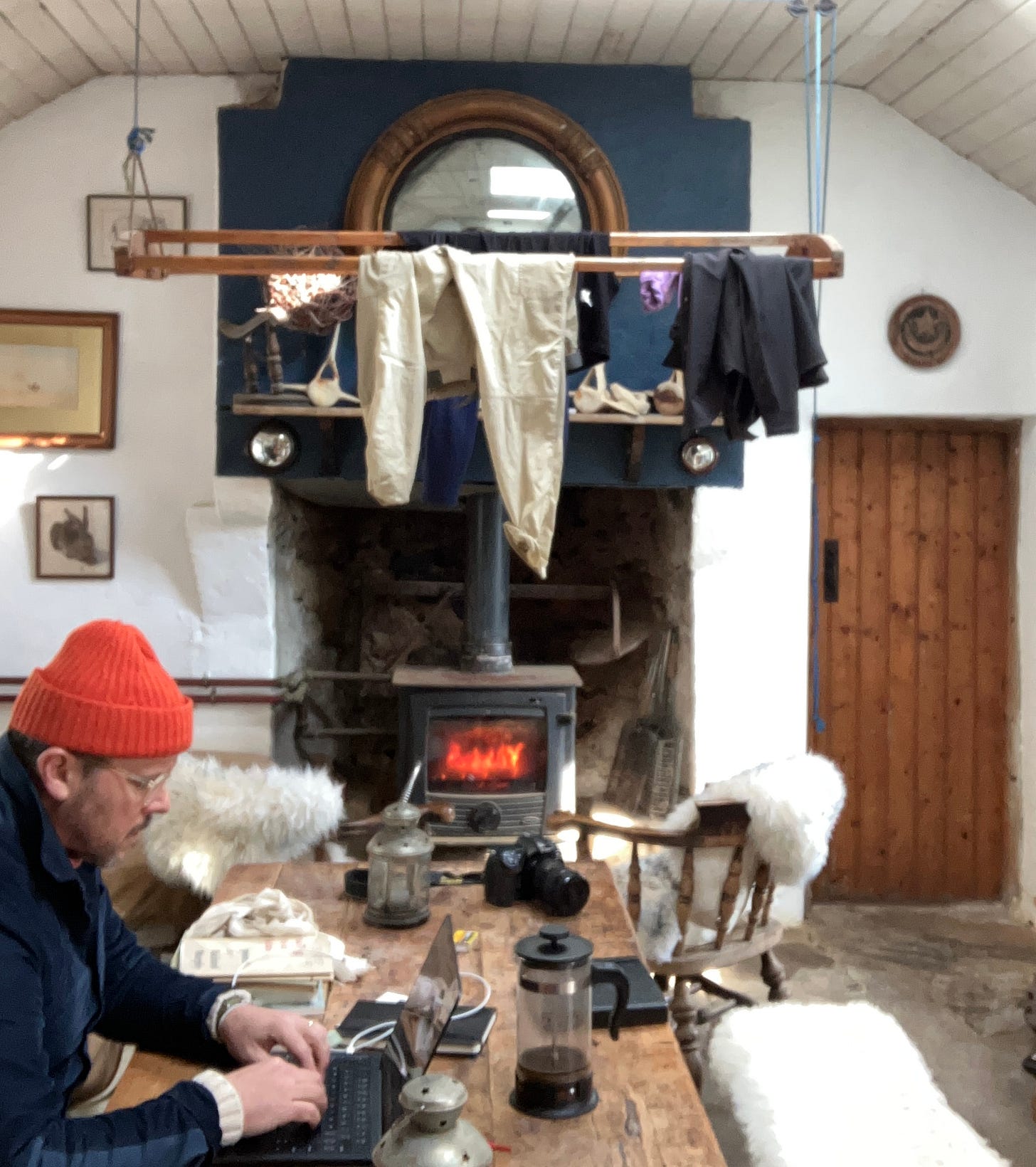There is a large cliff between the house in Port Donegal and the Glenlough Valley. Not a mountain but a wedge of land that juts upward and drops off to the ocean below like the edge of some gigantic brownie. It is a hike to get from one to the other, there are no full trails save for livestock routes that have been beaten down into the earth by years of sheep roaming free, at times to their peril for in days of fog the cliff and the land are hard to figure. I had been here before, 4 or 5 years ago, only for a day to hike with the owner of the cottage and see what it was all about. My friend Sophy had told me about it, she was friends with Roland who owns it. It was a place she had come to to write, a hut at the edge, and it was wonderful. This cottage is the perfect ratio of curio and craft, and reminds me that in a time when bigger is thought to be better, most times a small perfect proportion is all we need. I could spend years in a place with a wee fireplace, especially when the coast is close with its constant changing and light.
It is off grid, 20 kms from the village, down the end of the road where the ocean eats the gravel. Once you hit the Atlantic, look right and on the hill is the building, stone on stone, thick walled. I came back to stay at the cottage and to make the hike over to Glenlough. It has stuck in my brain and kept me up at night, it was a place I had to see as an end in itself.
It is a special place, Port and Glenlough Valley; it is craggy and sea stacked, weathered and moody, and for a particular soul, someone who embraces this sort of thing, this place is magic.
Bonnie Prince Charlie is said to have hidden out here for a year and a day. A year and a day, an old pagan timing that carries weight. In feudal societies, if a serf ran away and was absent from their lord's holdings for a year and a day, they were automatically considered free. In Scotland, a couple who lived together for a year and a day were accorded all the privileges of marriage, whether or not they were formally wed. In the Wife of Bath's Tale, poet Geoffrey Chaucer gives the knight a year and a day to complete a quest. And in The Owl and the Pussycat, “They sailed away, for a year and a day, To the land where the Bong-Tree grows.” A built in concept of escape and resurrection after some sort of metamorphosis due to time.
Artist Rockwell Kent came to the valley twice, in the 1920s and again in the 1950s after a legal battle with the US Supreme court on McCarthyistic restrictions of passports and travel (a battle he won and reminds me of current events on cell phones being searched and paranoia running deep: Kent V Dulles 1958). Kent was told he was not able to leave the USA, his passport was held, and he fought. His second visit in the 1950’s was to purchase the valley, but due to the court case he was delayed and missed his chance. The family that currently owns the valley purchased it instead and has owned it since.
Poet Dylan Thomas came too, as prescribed by his editor and friend to dry out for a season. Little did his editor know this was a capital for Poitín making, a potent hooch made from barley mash. Dylan wrote poems like “I, in my intricate image” and “Alterwise by owl-light” in an Atlantic haze of wind and weather and distilled spirits.
“This was the god of beginning in the intricate seawhirl,
And my images roared and rose on heaven's hill.”
There was something with this valley, something sublime and melancholic but also angelic and heavenly. It is misty and lost, the yin and the yang.
I began the walk knowing where to go. Roland and I had walked in the fog last time I was here, and the route was remembered (video above). That time, four years ago, we made it to the top, but I had to turn around to drive back to Dublin and to catch a flight so I wasn’t able to see the valley, the air being too thick, but I could feel a great space behind the mist, I could sense it. This time, I reached the end of the remembered route and crested the transition point where I was no longer in one valley and had entered into the Glenlough. This time though it was clear, blue skies, March temperatures; so crisp and perfect for hill walking. I could see the valley whole. The livestock trails shifted into thick bog and tufts and I began to lose any certain way, I was off-piste. There are no trees so you can see long distances, so I wouldn’t say I was lost, but I was on rocky, strange terrain. I could see the old houses left, piled rocks, Rockwell Kent's hut, and I decided to walk straight down the hill to the ruins. The plantlife was thick and there were rocky cracks in the landscape that are ideal for capturing ankles which made me nervous. While there was cell phone reception back in Port, in Glenlough I was cut off, miles away, and alone, and I must admit it felt wonderful.
It is getting harder and harder to be cut off from all these days. There are so many places that once were out of touch that have come into a yolk of technology and electric waves. I have been in the Gobi, on the Great Wall, on Machu Picchu, and the Orkhon Valley, all with 5 bars of cell service beaming down and into my phone. But here in Glenlough, I was subject to wind and weather and history alone, and it felt human. It could be psychosomatic but I could feel a lightness. I could also feel fear as I didn’t want to break a leg on this descent into the valley. I imagined having to crawl my way back up and over the cliff.
I realized my remoteness and could feel it, I could feel risk and fear. I walked slowly and deliberately step by step, stumbling at times but hard headed and set on keeping on until I reached the hut where Dylan Thomas, Rockwell Kent, Bonnie Prince Charles all hid away, escaping the same things in certain ways. I finally made it. I say that like it was a long journey, but to be honest I have no idea how long it took. It felt long but could have only been 10 minutes, I was in that strange state of presence and lack of distraction, where time slips away and you are just there, omnipresent. I reached the ruins of the old house and I sat down and ate my lunch and remembered something I had forgotten when I became excited by seeing the valley, when I became overwhelmed with a goal. I forgot that the way from point A to point B is seldom a direct line. That I should listen to the animals and follow their trails, the sheep know the route (even the ones that fall to their death on the cliffs as it is only in the mist when they lose their way). In mountaineering, to get to the top there are switchbacks, when you sail you tack, you twist and turn. It was foolish to rush down into the valley and I would not make that mistake on my return to Port post lunch. The idea of optimal efficiency, speed, and growth is one of folly and sounds much more like the chosen activity of a parasite rather than a human.
Somewhere along the way we forgot that the longer path can have its own virtue, that efficiency isn’t a golden ticket, that some things are horribly inefficient but are wonderful and worth experiencing. Consumptive thoughts of efficiencies and profits. I blame currency. It feels like we are more and more often forced to talk about things in economic terms, that if a choice or a decision or an argument is made it must be convincing economically. If we are in a debate about protecting a library, or a national park, or an arts program, we have to make it appealing for economic growth rather than an end in itself; that art, or books, or parks have value not in economic terms, but valued in natural, spiritual, religious, emotional, metaphysical terms. We have forgotten the value of the poets. We should protect art not because of its economic value, but because it is emotionally evocative.
Thank the gods the sheep were there to remind me in their blank stares.
The sheep first head down towards the water. The beach in Glenlough is not sandy and welcoming, it is a drop off of the bottom of the valley 30 feet or so to rocks and sea stacks and it is locally known as Bonnie’s Bath . The sheep walk down from the ruins towards the bay then turn left back up the edge of the cliffs, the long way up and over back to Port. So that is the way I went.
When Dylan Thomas was here he would walk the same route. He wrote letters to his friend Bert Trick in Wales saying “here are gannet and seals and puffins flying and puffing and playing a quarter of a mile outside my window where there are great rocks petrified like the old Fates and destinies of Isa, and smooth white Pebbles under and around them like The Souls of the Dead Irish. There's a hill with a huge Echo. You shout “I am dead” and the dead Irish answer from behind the hill. I forced them into confessing that they are sad gray lost Forgotten Dead and damned.” Solitude for Thomas didn’t fit, or it wore off with the amount of time he was here alone. For me, a few days in solitude shines. To spend time in places like this, places where magic still functions, leaves tide marks. It is rare, or seems to be, when more and more value is measured by commerce, the abstraction and distortions of belief into coinage as opposed to sacred nature, art, and objects that transform. Life lived in these realms, these places where value is judged by emotion and heart are a slice of something special, something worth seeking and saving. Something shifted when we misplaced our relationship with circadian rhythms, but it is always close by to be found again. When all we have to remember is that our grasp of the physical reality is sparse and fragile, that after a few pints we start to slip out of it, that with meditative breathing practices we can shift our sensations and our empirical world, that all we have to do to slip out of this world and into another is to lay down each night and sleep, to dream.










A wonderful post. And that first photograph is extraordinary.